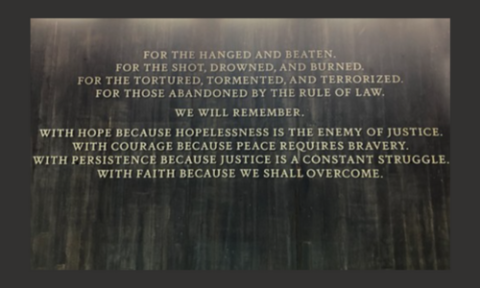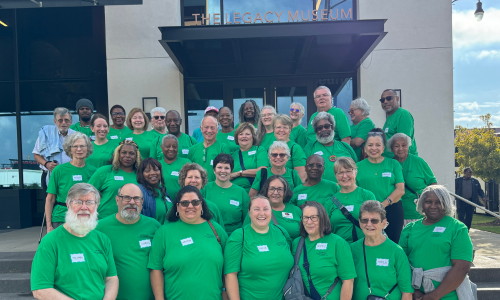
Last month, friends from East and West Ohio Conferences traveled to Montgomery, Alabama for the “Micah 6:8 Love Your Neighbor Tour.” The group toured The Legacy Museum for an immersive journey through American history viewing it from the perspective of black and brown sisters and brothers.
In reflection on this tour, Rev. Kathy Dickriede, Director of Missions and Community Engagement for the East Ohio Conference, shares her experience and the actionable steps the group is committed to taking in response to this journey.
Micah 6:8 Love Your Neighbor Tour
It all began on March 11, 2024, when the West Ohio Conference of The United Methodist Church (UMC) hosted Bryan Stevenson of the Equal Justice Initiative (EJI) during one of Bishop Gregory Palmer’s Leadership Clinics. After the clinic, many were committed to learning more about racial injustice issues. In June 2024, a group of students journeyed the “Long Arc of Justice”, a cross-cultural immersion course through the American South at the Methodist Theological School in Ohio (MTSO). Add All In Community - add Ohio UM restorative Justice Network - and the Holy Spirit into the mix, and the Micah 6:8 “Love Your Neighbor” Tour was born.
A cohort of 39 people from the East and West Ohio Conferences traveled to Montgomery, Alabama, to the Equal Justice Initiative’s Legacy Site Museums and the Troy University Rosa Parks Museum on September 24-27, 2024.
Before the journey, the Micah 6:8 cohort read How to Fight Racism by Jemar Tisby, met three times virtually to get to know one another, and participated in listening circles. There was also a sharing of firsthand experiences with racism. The group was diverse racially and geographically and included laity and clergy. Attendees traveled with spouses, parents, and children. We came with our individual stories and life experiences. While traveling to Montgomery, we watched the movie Just Mercy for a deeper introduction to Bryan Stevenson and his justice work. We also reviewed Bishop Palmer’s conversation with Stevenson during the Leadership Clinic.
The Legacy Museum is an immersive experience to be seen, felt, and heard, through images that transport you back in time. Together our tour began with the year 1619, the start of the Atlantic slave trade in the U.S. and through the modern-day systemic mass incarceration of Black people across our country. We journeyed through the Civil War, Reconstruction, terroristic lynchings, Segregation and Jim Crow, the Civil Rights Movement, and Mass Incarceration. Afterwards, we spent time sharing our emotions in response to the tour.
That afternoon was spent at the National Memorial for Peace & Justice. This was a striking site commemorating the locations and lives lost through the more than 4,700 lynchings that have taken place in the U.S. We saw large casket-like, hanging, and stacked sculptures engraved with names and locations of those killed by lynching. Another representation of tragic loss was presented at the Legacy Museum through large mason jars filled with dirt from lynching sites. These honor the Black men and women wrongly accused, tortured, and unjustly murdered. While the majority of lynchings occurred in the southern states, these markers make clear these horrific lynchings occurred all over the country.
Day two of the tour took us to the outdoor Freedom Monument Sculpture Park along the Alabama River. Its location reminds visitors that because of its proximity to the Alabama River, the slave trade led to Montgomery’s thriving. The enslaved built the railroad to expedite the slave trade, facilitating future enslaved persons chained together, jammed into railroad cars, and transported to auction blocks in the center of the city. Trafficked Africans were treated like cattle and sold. Enslaved families were separated and likely never found each other again. The slave trade fueled the economy in Montogomery as well as other major cities including Charleston, New York City, Richmond, Boston, New Orleans, Newport, Wilmington, and Savannah. The Legacy Museum and the Freedom Monument Sculpture Park are located where Montgomery’s slave market and slave warehouse once stood.
The following day our group met with staff from EJI to learn more about their work. EJI works to exonerate those wrongfully placed on death row, commute excessive prison sentencing, fight the conditions stemming from poverty, investigate lynchings to honor the lives of those who have been lost, and have these locations marked as historical sites, EJI also addresses the incarceration of children within the adult population. These are a few of the ways EJI is committed to transforming the justice system in each state.
Our final stop was the Troy University Rosa Parks Museum where we were transported back to December 1, 1955; the formal “launch” of the American Civil Rights Movement. We learned of the magnitude and power of social change that can occur from the determination of a few people and left challenged to consider our power to make a difference in the world.
Acknowledging and telling stories about the horrors of America’s racial injustices is the beginning of justice work. Information is power. For me, it was humbling to realize I have lived 53 years and did not know the details of these atrocities. Humility is necessary to be open up to learn new discoveries, confessing and lamenting. Mercy is the result of listening with compassion and believing. Healing is worship, prayer, and anointing. Making disciples ---of ourselves and others for the transformation of the world. Each of our lives have been forever transformed by this Micah 6:8 Tour.
What will we do? Will Micah 6:8 be more than the title of our journey and the words on the back of our T-shirt? Below are actionable items we can bring back to our ministry contexts and lives.
· Converse with our family and friends
· Lead a journey to civil rights and historic sites in Ohio.
· Visit The Legacy Museum Sites with family.
· Talk with our state justice leaders to find out what is happening in our state for our BIPOC community.
· Research the criminal cases of those who might have been wrongly accused or tried.
· Find out about your state’s death row policies and the system practices that perpetuate death row convictions.
· Look into systemic issues that affect poverty and criminal justice involvement.
· Talk to our pastors and congregations about our experience.
· Continuing learning and providing resources for others
· Join an anti-racism cohort to do anti-racism work.
Comments from other attendees on the Love Your Neighbor Tour
“We came to this experience as a group of 39 individuals. Each individual has the power to make an impact with our choices every day, just like Bryan Stevenson and Rosa Parks. We are a part of a wider culture where it will take groups of people to generate power to make systemic change. We aren’t in this alone. We cannot do this work alone. We must do this in community. Even Bryan Stephenson had Eva Ansley from the beginning of this journey. We have God and each other. And with God, all things are possible. Amen. I was taken with Bryan Stephenson's description of being “proximate” to suffering so we can understand the experiences of those who suffer from inequality. Micah 6:8 asks us "What does the Lord require of you? To act justly, and to love mercy and to walk humbly with your God." I believe being proximate to those who struggle is something we all can do as we seek justice in this world and walk humbly with God. Learning about mass incarceration, visiting the prisoner, and advocating for restored citizens as they return to society from prison are all practical and achievable. I think the church can be a beacon to this work by focusing on being proximate and close to those who endure injustice.”
-Tammey Wilden, East Ohio Conference
---
“For those moved and called to justice work, Micah 6:8 is a command. When the opportunity presented itself to “love my neighbor(s)” by traveling to the Legacy Sites in Montgomery, Alabama, I felt it was a big, necessary, and right next step toward advancing the anti-racism work of the United Methodist Church in Ohio. Then, when in his conversation with former West Ohio resident Bishop Gregory Palmer, during an installment of Bishop Palmer’s Leadership Clinic, Bryan Stevenson made clear that doing justice work requires proximity, making this trip, coming again, with others, so painfully close to the horrific truths of slavery and mass incarceration, was further validated. It brought me and my son together with over thirty other like-minded and like-hearted individuals, to see, hear, and feel the many years, the many ways, the depth and breadth of racist acts, indoctrination, and custom to be undone, and the many anti-Black systems to be dismantled to bring about racial justice. It is going to take years and many acts of God, like this trip. For the love of mercy and for the sake of doing justice, I’m glad we went.”
-Tracy Chambers, West Ohio Conference
---
“Brian Stevenson believes that we could change the tide of racism in a generation or two if those in the United States would learn and own our history. This gives me hope and stirs a commitment to be a part of that process. I was powerfully struck by the manner in which racism in “America” was born in the U.S. Church and is today perpetuated by us. That is a convicting realization.”
-Annette Dimond, East Ohio Conference
This commentary was written by Rev. Kathy Dickriede, Missions & Community Engagement Director for the East Ohio Conference of The United Methodist Church.
